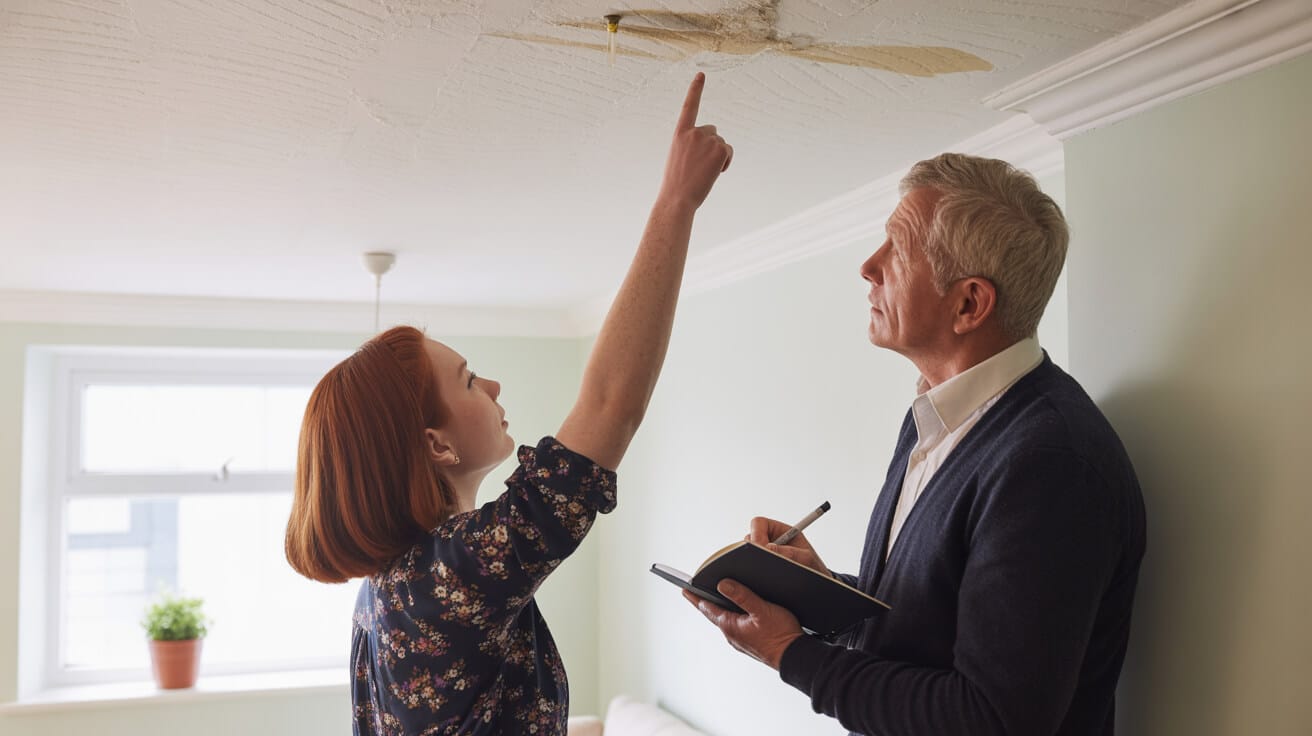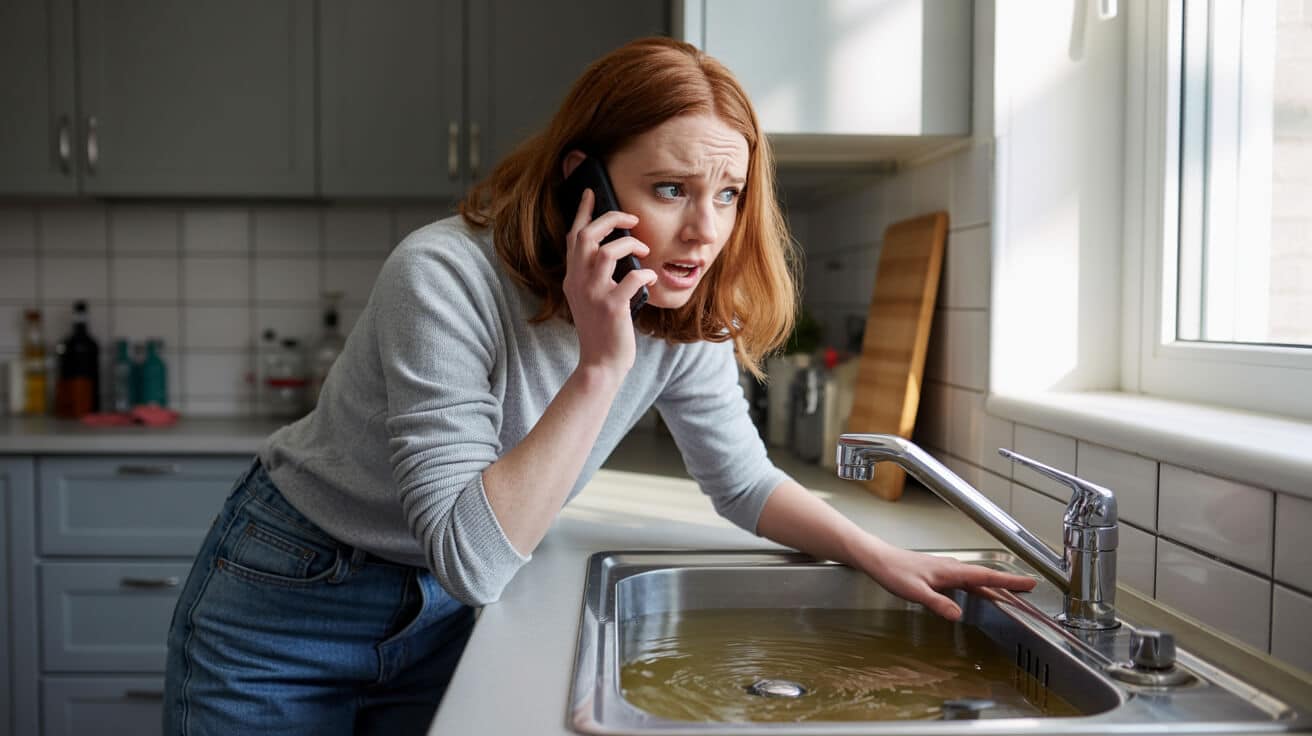 How to Find and Repair Common Water Leaks
How to Find and Repair Common Water Leaks
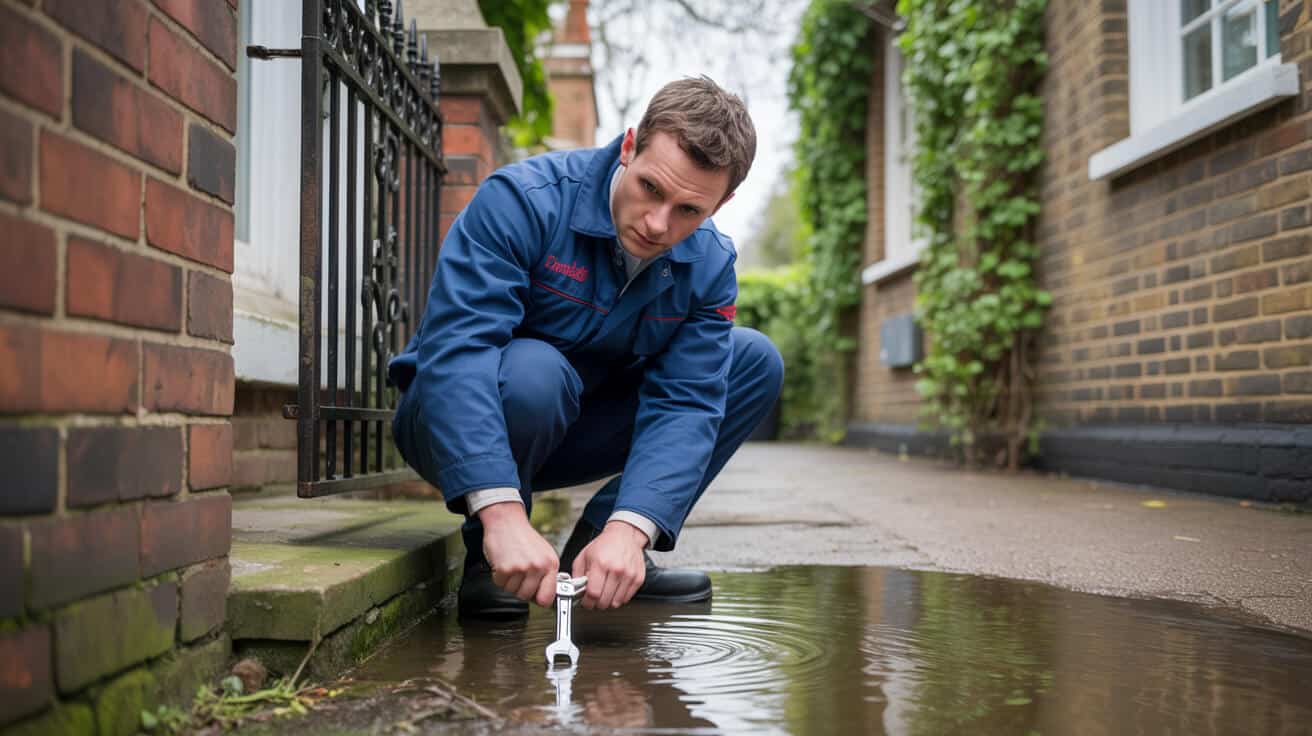
Where Do Water Leaks Start Hiding—and Why Should Homeowners Act Sooner?
Water leaks take root in places you rarely notice—behind a bathroom unit, beneath flooring, inside a wall that seems solid until you catch a musty tang or spot a faint stain. Most property owners underestimate not just how leaks begin, but how quickly they pile up damage, cost, and regulatory liability. It’s not the loud drip but the ones you never hear that eat through your equity, undermine tenant trust, and quietly tip you into unwanted insurance or legal entanglements.
Most leaks start small. The real problem is what grows around them when they’re ignored.
Your first warning may be subtle—a bill creeping higher, condensation in a place that never felt damp, or a patch of wallpaper that starts to bubble. Thames Water confirms that more than half of household leaks go undetected until costs spike or a neighbour flags a problem (Thames Water). These “slow leaks” multiply risk for every homeowner, landlord, or commercial manager who leaves them unchecked. Delay doesn’t just erode capital—it delivers headaches you’ll feel for months or even years: hidden structural rot, persistent mould, or tenant complaint chains that end with authorities stepping in.
Proactive leak checks aren’t just for perfectionists—they’re a baseline standard for safeguarding your investment and meeting UK compliance expectations. Every day you wait, repair costs and insurance hurdles rise, while the odds you face enforcement action tick up. Responsible management starts with vigilance, not reaction: the clients who regularly check for undetected leaks sleep soundly because they know what’s happening inside their walls—and because their paperwork is as watertight as their pipework.
Acting Sooner: Where Pounds and Trust Are Won or Lost
- Repair costs spike with delay: A £20 washer swap can save a four-figure restoration.
- Insurers and regulators expect proof: Waiting too long? Claims and compliance may falter without documented action.
- Tenant and reputation risk: Persistent leaks and dampness fuel complaints, churn, and negative reviews.
- Peace of mind is earned, not granted: Savvy owners and managers see leak checks as pure asset protection.
Ignore those early signals, and you’re not just risking a soggy floor—in a compliance-driven landscape, you’re gambling the reputation and value of every property you touch.
What Are the Signs of a Hidden Water Leak in Your Home or Business?

Most leaks masquerade as “normal life”—a subtle mark on the skirting, a faint whiff of mustiness, or a shadow in the back of the airing cupboard. It’s this subtlety that drives up long-term costs, and this is where proactive homeowners and property managers set themselves apart. Acting early isn’t about anxiety; it’s about spotting the common signals before water does what it always does—find the fastest, least convenient path to trouble.
Your property always leaves a trail—even if the leak is silent.
Physical Signs: What Your Eyes Can’t Unsee
- Ceiling or wall stains: Especially near bathrooms, kitchens, or above ground-floor flats—often the first tip-off of a hidden leak.
- Persistent black or greenish mould: Mould that keeps reappearing, even after aggressive cleaning, usually means water is present where it shouldn’t be.
- Flaking paint or bulging wallpaper: Surfaces that warp or bubble are almost always riding on a tide of moisture.
- Swelling woodwork: Skirting, door frames, or built-in cupboards taking on water, losing structural crispness, or feeling suddenly spongy.
- Squelchy floors: A hollow sound under tiles, bouncy laminate, or carpet that feels damp underfoot all suggest trouble below.
Sensory & Mechanical Cues
- Persistent musty odours: When cleaning and airing out don’t fix the smell, suspect slow, persistent leaks.
- Unusual pipe noise: Hissing, chattering, or movement in pipes when no taps or equipment are running.
- Pressure drops: A sharp drop in pressure, or spluttering taps, can mean water is escaping unseen along the run.
Property Management and Large-Building Red Flags
- Heating imbalances: Isolated cold radiators or patchy warmth often link back to central heating leaks or trapped air in system loops.
- Basement or plant-room humidity: Persistent condensation or unexpected dampness often reveals underlying or inter-floor leaks.
- Repeat complaints from tenants or staff: When damp, smells, or stains become a recurring theme, it’s a diagnostic clue that beats any gadget.
Detecting leaks early is as much about systemised inspection as it is about technical prowess. Owners and managers who document issues as soon as they’re spotted—photos, sensor logs, dated notes—are armed when talking with insurers, engineers, or legal teams. It’s your defence layer, proving you acted responsibly while others waited for disaster.
How Can You Use Your Water Metre to Detect Leaks Fast?
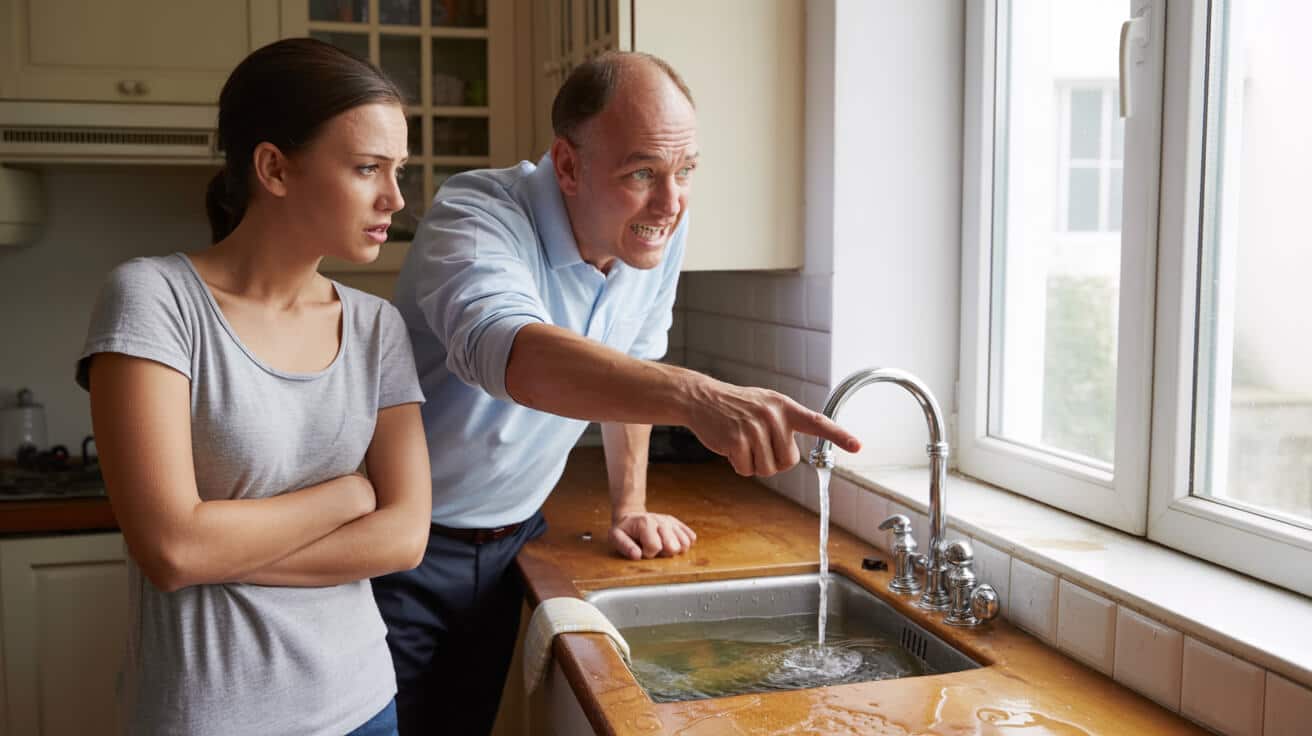
Your water metre isn’t just about measuring usage—it’s your first responder in detecting silent leaks before they wreck floors, insulation, or client trust. Relying on “DIY intuition” when you have a built-in tool for verification is a mistake that costs time and money. Here’s how to bring evidence and certainty to a suspicion—without waiting for the next utility bill or a visible disaster.
A 10-minute metre test can save you hundreds in repairs and catch leaks before damage spreads.
Stepwise Leak Confirmation Using Your Metre
- Shut off every tap, appliance, and toilet—let everyone onsite know to avoid water use for at least an hour.
- Locate your water metre—normally outside near your property line, or in a pavement box.
- Log the exact reading—take a photo or write down both the main dial and any decimals.
- Wait a measured interval—60 minutes covers most leaks, overnight catches even slow ones.
- Re-check and compare—movement in the reading means water is leaving the system—with nobody using it, this nearly always points to a leak (BobVila).
Professional Property/Portfolio Application
- Create a reference log: for every property: monthly for high-usage or multi-user buildings, quarterly for single lets or owner-occupiers.
- Archive metre photos: with time stamps—this creates incontrovertible evidence for insurers, compliance audits, or tenant disputes.
- Flag unexpected changes: in pressure or usage between logs. A jump triggers immediate investigation, not “wait and see”.
Proving a leak exists, fast, protects your reputation, limits loss, and cuts through potential conflicts with stakeholders. Data doesn’t argue—owners who document, win.
Where Do Most Plumbing Leaks Start—and What Should You Check First?
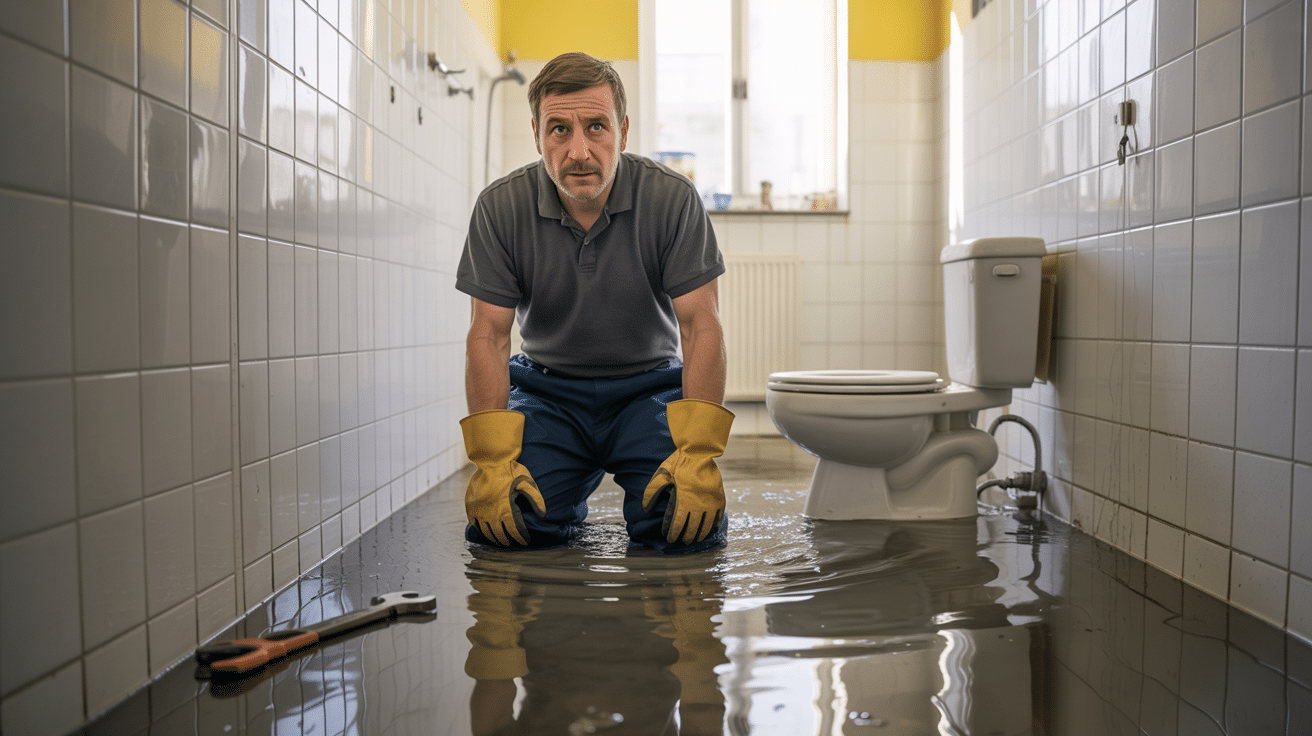
Most leaks occur exactly where pipes, joints or appliances are under stress—never in the handy, easy-to-access spots. Understanding the architecture of your plumbing dramatically increases your odds of a fast fix versus a drawn-out saga. Proactive inspection focuses effort where history (and every callout log) says you’ll find 90% of issues.
Leaks almost always start at a joint, bend, or fixture you use every day—rarely in the middle of a pipe run.
Typical Trouble Points: Domestic and Commercial
- Under sinks, wash basins, and around traps: Loose compression joints or cracked washers account for a large proportion of service calls.
- Toilets and cisterns: Dripping into the pan or onto the floor, often from worn flush valves or corroded supply connectors. The “food dye” test reveals if a system is silently leaking ([BobVila](https://www.bobvila.com/articles/how-to-find-a-water-leak/?utm_source=openai)).
- Appliance hoses: Especially for washing machines and dishwashers, where movement or vibration loosens fittings over time.
- Shower trays and bath surrounds: Broken silicone seals or missing grout leaks are hidden until they reach ceilings below.
- Hidden pipe runs: Particularly after poor DIY work, freeze-thaw cycles, or in buildings older than 30 years.
Commercial/Multi-Unit Property Hotspots
- Service risers and shafts: A single undetected leak can affect multiple units—watch for signs in common walls, ceilings, or basements.
- Plant room cylinder bases, expansion valves: Look for early puddling or flaky mineral build-up.
- Radiator and valve bases: Even a crust of corrosion marks a slow, steady leak that wastes energy and can lead to bigger faults.
Fast-Action Inspection Checklist
- Physically touch all exposed joints and connectors: —look for dampness or slime.
- Shine a torch behind or beneath units: —visual checks spot issues long before a drip comes through the ceiling.
- Move lightweight appliances gently: to check for residual moisture or signs of previous pooling.
- Log issues with photos: for insurance, compliance, or escalation to contractors.
Ten minutes monthly on a “leak patrol” can head off disaster—especially in rental or multi-tenant buildings. Owners and portfolio managers who make this routine don’t just avoid breakdowns—they earn a quiet reputation for asset stewardship.
What Risks Do Water Leaks Create If Left Undiagnosed?

Ignoring a leak isn’t neutral—it’s an open invitation to compound risk. The direct cost is just the beginning: insurance refusals, landlord penalties, and escalating repair bills all follow if you wait. Resourceful owners, agents, or managers make this calculation clear: risk stacks up daily.
The biggest risk isn’t the water—it’s how much more you’ll pay if you don’t stop it soon.
The High Cost of Inaction
- Escalating water bills: Thames Water calculates a minor leak can add £100–£400 per year for homes, far more for commercial setups ([Thames Water](https://www.thameswater.co.uk/help/water-saving/leaks?utm_source=openai)).
- Structural decay: Water travels—damaging timber, plaster, and insulation, undermining your property’s very fabric.
- Insurance and legal risk: Insurers routinely reject claims where owners can’t provide prompt action evidence; landlords risk FHH (fitness for human habitation) action and significant fines.
- Destruction of assets: Profitable kitchens, bathrooms, and floors don’t survive persistent leaks; neither do warranties or tenant goodwill.
- Health and compliance impact: Mould and excessive moisture damage air quality and breach HMO or Section 21 requirements.
Delay Guarantees Loss: Risk Has a Compound Nature
Every month a leak continues, risks multiply—not just in repair cost, but in landlord compliance, asset devaluation, or lost tenancies. Credit, insurance standing, and local authority reputation all ride on proof you handled the problem early. A ten-pound part now can mean a thousand-pound letter from your insurer if you wait.
Should You Attempt a DIY Leak Repair, or Call a Certified Plumber?
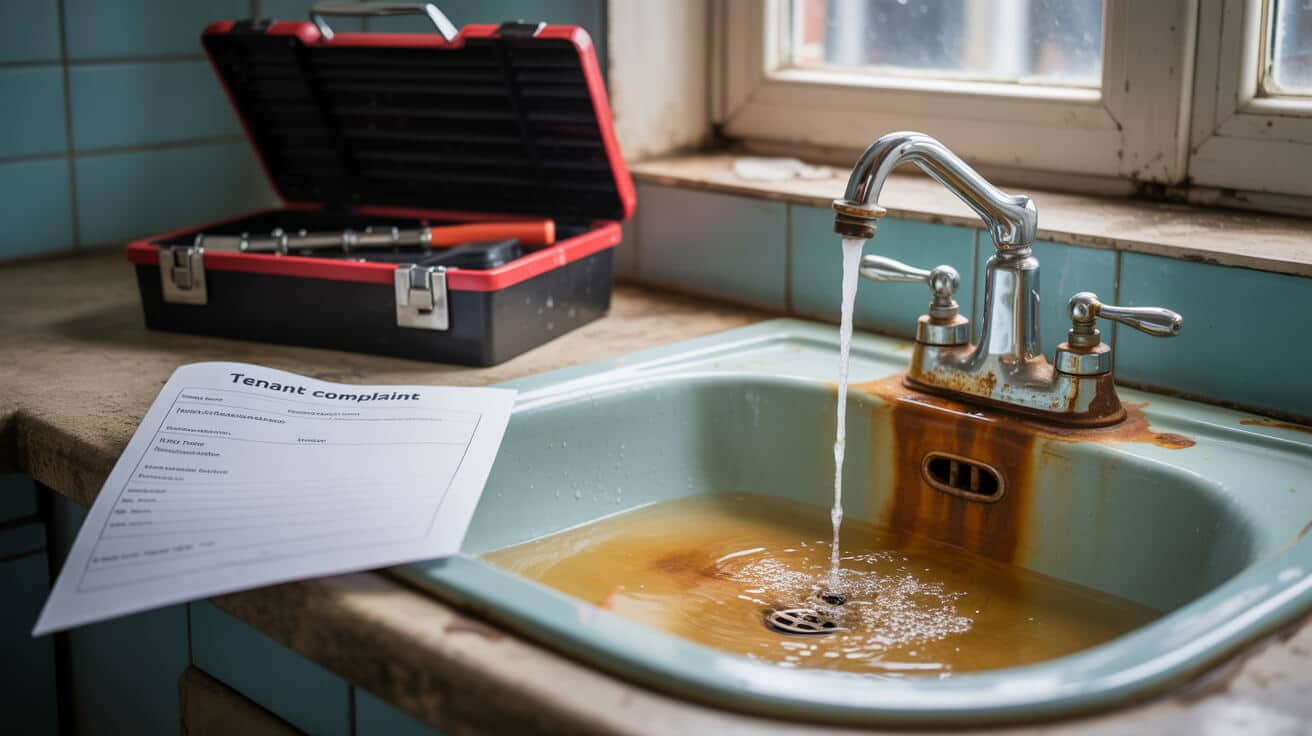
Every property manager and owner faces the “DIY or delegate” dilemma. What separates the sensible from the reckless isn’t bravado—it’s knowing the safety, regulatory, and financial lines not to cross. Some defects are simple wins with the right part and care; others are lawyer-magnets just waiting to bite.
DIY covers the fix you can see—peace of mind comes from knowing when to call in certified help.
When DIY Is Sensible
- The leak is visible and accessible: Taps, flexible hoses, and external pipe joints are generally safe territory.
- You’ve clearly identified the part: Can you match the faulty washer or valve with a WRAS-approved replacement?
- The fix won’t disturb electrics or major structure: Stay away from jobs that risk exposure to live wires, load bearings, or damp-prone voids.
Best-Practice DIY Protocol
- Shut off the property’s main supply using the stopcock—no exceptions.
- Dry and inspect the area: Confirm the leak and clean thoroughly, as dirt masks the real problem.
- Swap components or use WRAS-grade repair tape as a stopgap.
- Restore supply and inspect under pressure—no leak, no misting, no problem; otherwise, escalate.
- Document with photos, receipts, and a dated note—especially if you’re a landlord, agent, or have an eye on compliance.
When to Book a Certified Engineer
- Leak source is hidden, behind structure, or beneath floors:
- Proximity to wiring, controllers, or complex appliances:
- Multiple failed attempts or fluctuation in system pressure:
- Critical assets at risk; multi-unit impact possible:
certified engineers bring more than hands-on expertise: they deliver watertight documentation, part traceability, and insurance-grade repairs that future-proof tenancies, compliance, and asset value.
What Do Professional Leak Detection and Repairs Involve—And Why Is This Approach Essential?
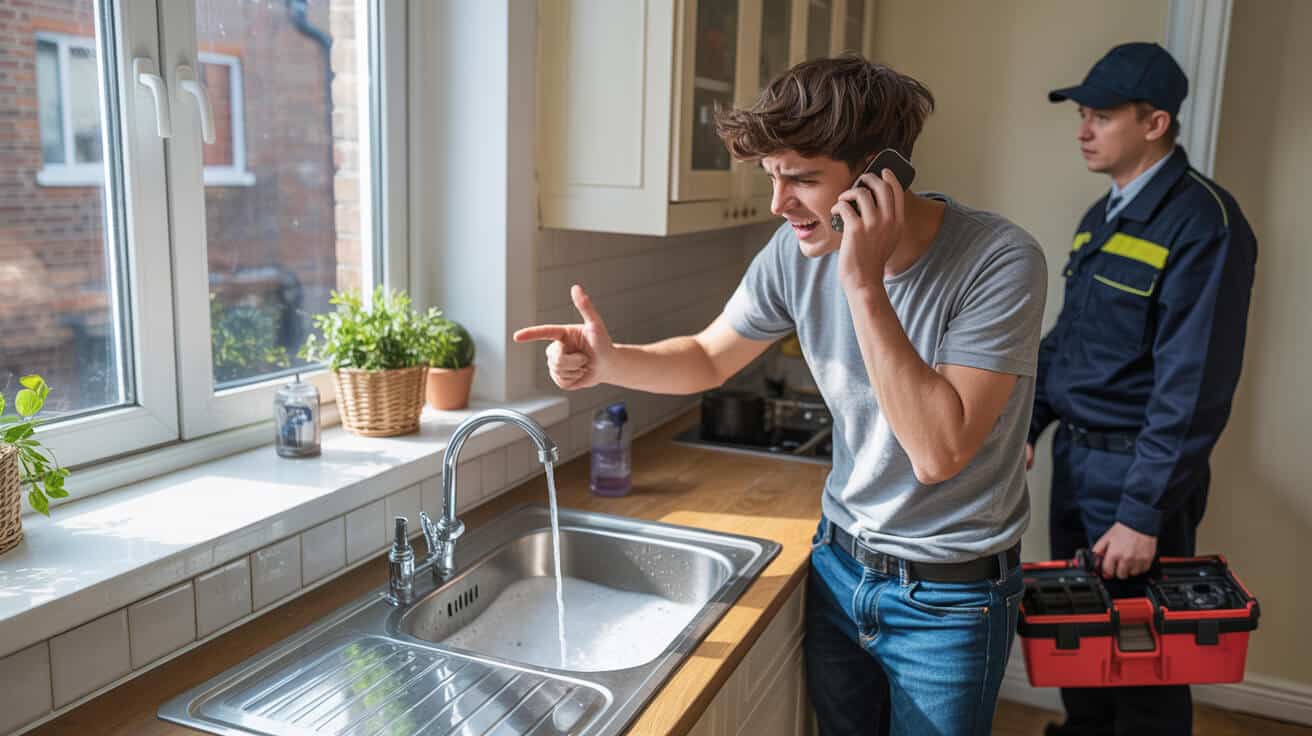
There’s a marked line between DIY and professional leak response. When the stakes are high—complex instals, regulatory compliance, multi-unit, or commercial environments—engineers deliver certainty that’s impossible to match with guesswork or “bit of tape” tactics.
True peace of mind comes from knowing it’s been found, fixed, and properly logged.
What Professional Diagnosis and Repair Looks Like
- Total system inspection: Not just fixing the visible leak, but tracing for *other* weaknesses in the same run—which saves the next callout.
- Advanced diagnostic kit: Thermal cameras, moisture metres, acoustic sensors, and non-destructive tracing to pinpoint hidden leaks without holes or invasive access.
- Pressure testing: Ensures no hidden faults persist once the main leak is patched—especially vital in multi-storey or back-to-back let spaces.
- Full compliance through WRAS/G3 parts: Repaired instals meet all insurance and compliance requirements, and are recorded for warranties.
- Photo and part documentation: Every repair comes with a photographic record, serial log, and compliance audit trail.
- Client handover: Professional walkthrough of the fix, review of any special ongoing checks, and all papers for your records.
Property value is built on trust—and trust is built on documentation.
For high-value, commercial, multi-let or regulatory properties, anything less is careless. Professional engineers like those at Plumbers 4U don’t just restore water flow—they future-proof your audit trail, tenant trust, and long-term investment.
How Can You Prevent Leak Recurrence and Maintain Your Property’s Value?
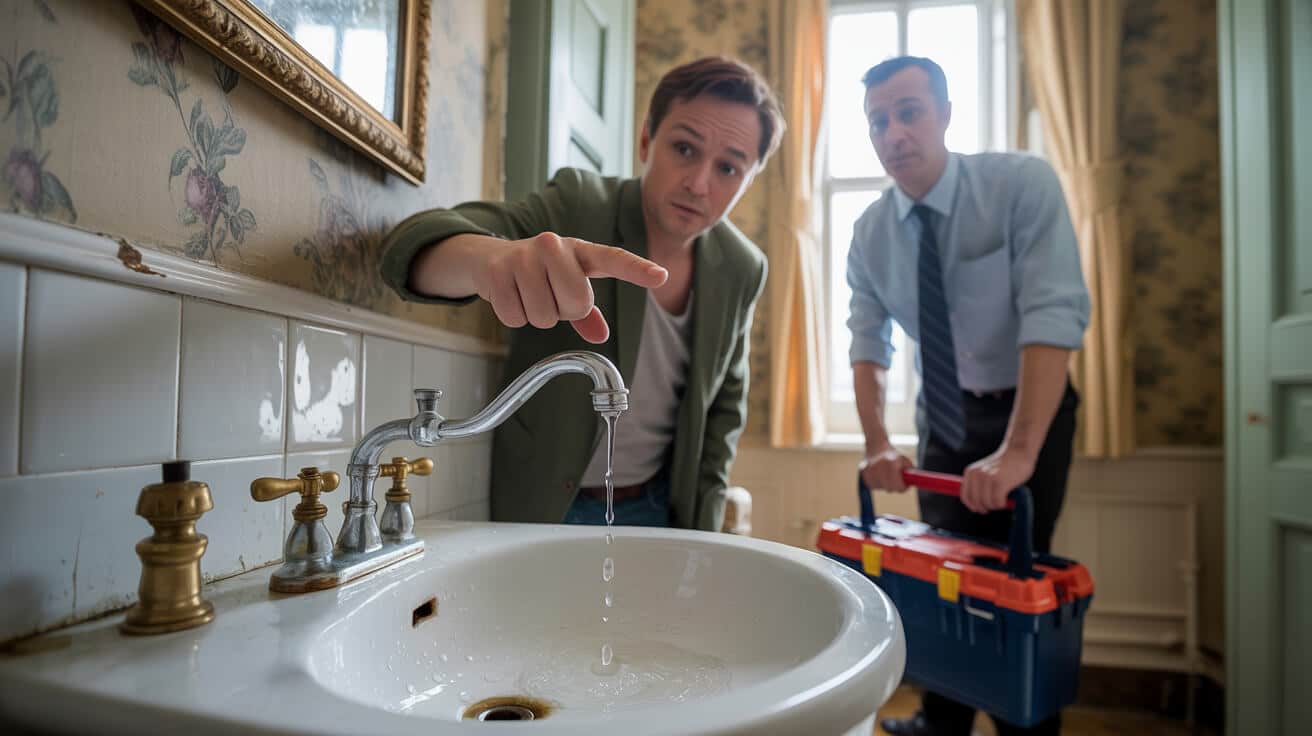
The savviest owners and managers understand that prevention is the only winning strategy. If you wait for symptoms, you’re already on the back foot; if you systemise vigilance, you almost never get blindsided by a crisis. How? Through scheduled checks, documented interventions, and educated occupants or staff—all backed by professional advice.
The easiest leaks to fix are the ones you never experience—thanks to vigilant maintenance.
Leak-Proof Maintenance: Your Actionable Plan
- Book annual full inspections: Certified engineers spot weak points, check metres, fixtures, hoses, and appliances with professional rigour. Make it a ritual, not an afterthought.
- Preemptive swapping of at-risk parts: Even the toughest washers, hoses, and valves have a shelf life. Scheduled replacement halves the call-outs for leaks.
- Keep a detailed logbook: Every repair, inspection, metre check, or part swap gets a time-stamped photo and note, ready for compliance audits or disagreements.
- Educate all occupants: Make the stopcock, leak symptoms, and emergency contacts clear to everyone using the building—ignorance causes delay.
- Insist on proper documentation for new instals: Only WRAS, WaterSafe, and G3-certified work delivers insurance-grade confidence (and long warranties).
- Add water quality, system, or leak sensors for sensitive assets: Especially in flats, commercial settings, or anywhere a small drip could do massive unseen harm.
Professional teams like Plumbers 4U systemise this as standard, delivering not just peace of mind, but paper trails that head off insurance headaches and raise the resale or rental value of any asset.
Book Plumbers 4U Today
Water won’t wait for your next free weekend. Every hour lost to indecision or inaction translates into silent property damage, mounting bills, and growing compliance risk. Owners, landlords, agents, and portfolio managers know the choices: act fast and you control outcomes; stall and you hand control to water, regulators, and accountants.
Every Plumbers 4U visit is led by certified professionals—WRAS, G3, and WaterSafe approved—with every job documented from isolation to sign-off. You don’t just get a fix; you get a bulletproof service report, compliance paperwork, aftercare instructions, and a genuine guarantee. Homeowners: this means stress-free repairs and extendable warranties. Landlords and property professionals: streamlined compliance, digital reporting, and confidence in every audit.
Don’t let a quiet leak escalate. Make your next water problem the last one you have to worry about—by choosing a team that puts documentation, compliance, and client-first service at the heart of everything.
Frequently Asked Questions
What property and ownership factors make some homes or buildings a “leak risk” long before obvious damage?
Water leaks don’t start with a flood—they start with invisibility. Any property can be at risk, but vulnerability climbs when you look at a few telltale signals: age, pipework type, layout complexity, and how many hands are actually involved in managing the space. Many leaks start their dirty work inside walls, cupboards, or beneath floors, ticking up your bill and quietly undermining structure and compliance, often for months.
The risk tightens as soon as multiple people are responsible—think landlords, letting agents, facility managers, even housing officers. Pipework threaded through party walls, voids between flats, or communal risers means that one person’s oversight can become everyone’s headache. The 2024 WaterSafe UK survey showed that over 60% of new damp or water ingress complaints in managed homes traced to leaks that began outside the caller’s direct control—a grim stat for anyone in a block, HMO, or older office building. Left to fester, you’re looking not just at swelling timber and peeling paint, but at insurance excesses, non-recoverable HMO fines, and angry tenants or buyers.
A missed leak is always more expensive for owners and managers than for tenants—the bill and the blame both go upstream.
Why does pipe layout or build type make a difference?
- Properties with a mix of copper, lead, and plastic are infamous for buried leaks and compatibility failures.
- Large buildings with extended runs—from attic tanks to basement appliances—mean more joints, more hidden risk.
- High-rise or multi-unit layouts create shared infrastructure; a riser leak may soak four flats before anyone acts.
- Frequent occupant turnover (student lets, serviced apartments, care homes) increases “unknowns”—tenants often don’t spot or report the early signs.
Being proactive and scheduling routine inspections—especially in vacant units and after any refurbishment—keeps control in your hands. That moves you from “panicked responder” to “asset protector”, locking in long-term value and compliance for your entire property stack.
Which early warning signs catch silent leaks before they boil over—and how can you confirm without costly damage?
Catching a leak early isn’t guesswork. It’s about methodical checks and not waiting for puddles. Start with metre logic—turn off all taps and watch if the dial moves; movement means water’s escaping somewhere, and that somewhere is getting more expensive by the hour. Move to hands-on checks: trace skirting boards and behind appliances for damp, bubbling paint, or even a cold patch on the wall. The human nose is surprisingly efficient—odd, musty smells can signal rot long before water stains show up. Bathrooms, kitchens, and airing cupboards are repeat offenders, so dig in there first.
A home-friendly test: add food colouring to your toilet cistern. If colour bleeds into the pan in 30 minutes without flushing, expect a slow, silent leak costing hundreds a year. For flats, watch ceilings below bathrooms. For houses, monitor unused rooms—damp can source from roof tanks or long, underfloor runs forgotten during renovations.
- Torch, compact mirror, and dry tissue: great trio for awkward corners.
- Check radiator tails and unlagged pipe sections after winter; frost-stressed pipes often drip below sightlines.
- Record every anomalous patch with a dated photo—this isn’t paranoia, it’s practical evidence that saves time and supports an insurance claim if things escalate.
No tool beats your own vigilance—a dry joint today can save a soaked ceiling tomorrow.
What free or low-cost leak hunting tools make the job easier?
- Portable moisture metres for wall or floor anomalies
- Phone camera for dated visual logs
- Printable leak walkaround templates (via WaterSafe UK or your insurer portal)
- Pocket thermometers to spot cold spots from pipe sweating or new seepage
If you still smell trouble but can’t see it, engineers have acoustic detectors, IR sensors, even tracer dyes—so don’t keep drilling holes. Get a pro in sooner to avoid structural surgery later.
When are DIY plumbing fixes allowed—and where do responsibilities or legal red lines appear for property managers and landlords?
You’re absolutely within your rights to fix a tap washer, swap out a flexible connector under the sink, or tackle a slow-dripping isolation valve—as long as you can physically access the fault, are working on your own property, and follow water safety codes. Always shut off your main stopcock before making repairs, and check for hidden electrics behind walls or at appliance connectors. Use only parts with visible WRAS approval markings.
Red flags pop up quickly for anyone responsible for someone else’s health, safety, or tenancy:
- Leaks inside wall, floor or ceiling voids, mixed-use risers, or anything needing disruptive access (cutting, drilling): stop and get a qualified tradesperson.
- If the leak relates to a hot water cylinder, central heating system, or any unvented pressurised unit: only a G3 or WRAS-accredited engineer is legal.
- Insurance, tenancy law, or health and safety compliance—any of these means a pro, not DIY.
- If you can’t restore water pressure fully or see new signs of damp after your fix, step back and call in an expert—you may have only addressed a symptom, not the source.
- Landlords, managing agents, and anyone with responsibility for others’ welfare must follow the Fitness for Human Habitation Act (2018); the bar is higher.
The line between ‘handy’ and ‘liability’ is thinner than you think—the moment you’re unsure, bring in the accredited pro.
What tasks are genuinely “DIY-safe”, and when does regulation or safety overrule you?
- Isolating supply and swapping a like-for-like tap, washer, or visible pipe fitting
- Fixing accessible, mechanical-only WC or cistern flush valves—no pressure or heating links
- Replacing a cracked appliance hose, visible clamp, or exposed compression joint
Tasks to never attempt:
- Any modification to an unvented hot water system, central heating pressure loop, or soil stack
- Work in occupied flats or communal buildings without full notification
- Anything requiring access to sealed electrical units, or risking gas safe territory
What documentation transforms a leak fix from a mere repair into airtight protection for owners, managers, and tenants?
Documentation is your silent insurance—and landlords, letting agents, and surveyors all know missed paperwork is often the root of six-figure losses. For every job:
- Date, time, and evidence of fault (location, suspected cause, first observed)
- Description of steps taken: who did what, when, with which parts or materials (keep part numbers and WRAS certificates)
- Photo log: minimum before/after, ideally a stepwise visual record (these are gold in legal disputes or resale)
- All receipts, engineer job sheets, and compliance or safety certificates (G3, WRAS, WaterSafe codes)
- Digital copies archived in the cloud, ideally with redundancy (Google Drive, Dropbox, etc.)
For rental or block-managed property, records should be shared with tenants and agents, demonstrating compliance and diligence. Electronic copies are much harder to lose, and also speed up future queries or resale.
| Document Type | Purpose | Best Practice |
|---|---|---|
| Detailed repair log | Shows responsive management, speeds claims | 6+ years retention |
| Engineer photo sheet | Compliance for audits/insurance | Lease +1 year |
| Approval certificates | Prove legal status, unlocks grants/sale | Indefinitely kept |
| Metre/water log | Documents new or ongoing faults | 1+ year, resets |
| Tenant/agent comms | Pre-empts liability claims | Lease duration |
A tidy digital paper trail costs nothing; missing one can cost your asset.
Which records do local authority or insurance audits always demand?
- Dated logs and photos (from discovery right through fix)
- Compliance sheets from the engineer (especially for high-pressure or HMO properties)
- Record of tenant/agent communications about the fault and the repair
- Proof of all compliance certificates
Archive well—if you can’t produce it, it might as well never have happened.
How do specialist plumbing companies detect and pinpoint hidden leaks with minimal damage—and why is certification so vital to owners?
Accredited engineers—think Plumbers 4U and other national teams—bring precision and peace of mind to leak detection and repair. Modern leak hunting is non-destructive: acoustic sensors “listen” for water escaping behind walls, thermal imaging cameras find cold spots behind tiles or floorboards, and moisture metres spot new damp before stains appear. This saves you money, saves the fabric of the building, and means less time spent reinstating wet walls.
Crucially, certified engineers log everything for you:
- Fault tracing evidence: photo, video, and data logs
- Manufacturer or WRAS/G3-approved part codes; legitimate, certifiable replacements
- Signed job sheets and certificates, including digital versions for insurance or compliance submission
- Pre- and post-repair evidence to support speedy claim approval or compliance audits
Trades certified in WRAS, G3, and WaterSafe have their work recognised by insurers, surveyors, and local authorities—your repairs stand up to scrutiny, disputes, or resale surveys. This isn’t “paperwork for show”, it’s what keeps your asset marketable and complaint-proof.
Smart diagnostics are half the fix; the right documentation is the other half.
What techniques separate professionals from general contractors or DIYers?
- Use of non-invasive detection (acoustic sensors, IR cams, tracer dyes)
- Issue manufacturer-approved parts, never “equivalents”
- Log book and digital photo trail of all work for your records
- Provide post-job support, warranty, and compliance reminders
Lock in the expertise—because one snapshot from a certified plumber is worth a hundred guesses on where the water sneaks in.
What habits and technology guarantee you stop leaks before they become a compliance or reputational crisis?
Staying ahead of leaks starts with discipline and shared accountability—there is no “one and done.” Build prevention into your schedule: set quarterly calendar reminders for a guided walkaround across every unit or floor, and use checklists to capture new or recurring warning signs. Make it a habit to check every isolation valve, accessible pipe joint, and overflow twice a year. Instal WRAS- and WaterSafe-approved leak detectors in high-risk or rarely used areas—these sensors can alert you by app or text before damp becomes a saga.
Invest in training: tenants, staff, even family need to know what a stopcock looks like and where to find the main shutoff. For agents or portfolio managers, set a standard to require timestamped photo logs for every significant repair—linked to the main digital file for each property.
Audit yearly—bring in a compliance-certified engineer to review, sign off, and reissue documentation. Don’t just react; build a living file so you’re ready for inspections, insurance, or resale with zero panic.
The properties that never panic are the ones with systems—not just quick fixes.
What’s in a best-in-class prevention and compliance plan?
- Quarterly walkarounds covering all visible and concealed joints, valves, and seals
- Smart detectors in kitchens, utility rooms, lofts, and at every main water entry
- Digital logbooks regularly updated after any inspection, repair or user report
- Clear induction info for new tenants/staff—including diagrams, emergency protocols, and direct contacts
- Annual compliance review (WRAS/G3/WaterSafe) with documentation, adding to your living file
With discipline, simple tech, and clear communication, your risk drops, compliance rises, and your asset’s reputation becomes non-negotiable.
Ready for plumbing certainty—not just a fix, but a bulletproof record and real property confidence? Book your WRAS/G3/WaterSafe-certified Plumbers 4U engineer today and build the system your tenants, managers, and insurers trust.

